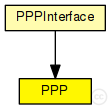 This documentation is released under the Creative Commons license
This documentation is released under the Creative Commons licensePPP implementation.
Packets are encapsulated in PPPFrame.
PPP is a complex protocol with strong support for link configuration and maintenance. This model ignores those details, and only performs simple encapsulation/decapsulation and queuing.
In routers, PPP relies on an external queue module (see IOutputQueue) to model finite buffer, implement QoS and/or RED, and requests packets from this external queue one-by-one.
In hosts, no such queue is used, so PPP contains an internal queue named txQueue to queue up packets waiting for transmission. Conceptually, txQueue is of infinite size, but for better diagnostics one can specify a hard limit in the txQueueLimit parameter -- if this is exceeded, the simulation stops with an error.
There is no buffering done on received packets -- they are just decapsulated and sent up immediately.
See also: PPPInterface, IOutputQueue, PPPFrame

The following diagram shows usage relationships between types. Unresolved types are missing from the diagram.

The following diagram shows inheritance relationships for this type. Unresolved types are missing from the diagram.

| Name | Type | Description |
|---|---|---|
| PPPInterface | compound module |
PPP interface. Complements the PPP module with an output queue for QoS and RED support. |
| Name | Type | Default value | Description |
|---|---|---|---|
| interfaceTableModule | string |
The path to the InterfaceTable module |
|
| txQueueLimit | int | 1000 |
only used if queueModule==""; zero means infinite |
| queueModule | string | "" |
path of external (QoS,RED,etc) queue module |
| mtu | int | 4470B |
| Name | Value | Description |
|---|---|---|
| display | i=block/rxtx |
| Name | Direction | Size | Description |
|---|---|---|---|
| netwIn | input | ||
| netwOut | output | ||
| phys | inout |
| Name | Type | Unit |
|---|---|---|
| rxPkOk | PPPFrame | |
| packetReceivedFromLower | cPacket | |
| packetReceivedFromUpper | cPacket | |
| NF_PP_RX_END | TxNotifDetails | |
| packetSentToLower | PPPFrame | |
| dropPkBitError | cPacket | |
| packetSentToUpper | cPacket | |
| txState | long | |
| dropPkIfaceDown | cPacket | |
| NF_PP_TX_END | TxNotifDetails | |
| NF_PP_TX_BEGIN | TxNotifDetails |
| Name | Title | Source | Record | Unit | Interpolation Mode |
|---|---|---|---|---|---|
| rcvdPkFromHL | packets received from higher layer | packetReceivedFromUpper | count, sum(packetBytes), vector(packetBytes) | none | |
| passedUpPk | packets passed to higher layer | packetSentToUpper | count, sum(packetBytes), vector(packetBytes) | none | |
| droppedPkBitError | packets dropped/bit error | dropPkBitError | count, sum(packetBytes), vector(packetBytes) | none | |
| droppedPkIfaceDown | packets dropped/interface down | dropPkIfaceDown | count, sum(packetBytes), vector(packetBytes) | none | |
| rxPkOk | packets received OK | rxPkOk | count, sum(packetBytes), vector(packetBytes) | none | |
| txPk | packets transmitted | packetSentToLower | count, sum(packetBytes), vector(packetBytes) | none | |
| txState | tx state | timeavg, vector | sample-hold |
// // PPP implementation. // // Packets are encapsulated in ~PPPFrame. // // PPP is a complex protocol with strong support for link configuration // and maintenance. This model ignores those details, and only performs // simple encapsulation/decapsulation and queuing. // // In routers, PPP relies on an external queue module (see ~IOutputQueue) // to model finite buffer, implement QoS and/or RED, and requests packets // from this external queue one-by-one. // // In hosts, no such queue is used, so PPP contains an internal // queue named txQueue to queue up packets waiting for transmission. // Conceptually, txQueue is of infinite size, but for better diagnostics // one can specify a hard limit in the txQueueLimit parameter -- if this is // exceeded, the simulation stops with an error. // // There is no buffering done on received packets -- they are just decapsulated // and sent up immediately. // // @see ~PPPInterface, ~IOutputQueue, ~PPPFrame // simple PPP { parameters: string interfaceTableModule; // The path to the InterfaceTable module int txQueueLimit = default(1000); // only used if queueModule==""; zero means infinite string queueModule = default(""); // path of external (QoS,RED,etc) queue module int mtu @unit("B") = default(4470B); @display("i=block/rxtx"); @signal[txState](type=long); // 1:transmit, 0:idle @signal[rxPkOk](type=PPPFrame); @signal[dropPkIfaceDown](type=cPacket); //TODO currently both upper and lower; todo separate them @signal[dropPkBitError](type=cPacket); @signal[packetSentToLower](type=PPPFrame); @signal[packetReceivedFromLower](type=cPacket); @signal[packetSentToUpper](type=cPacket); @signal[packetReceivedFromUpper](type=cPacket); @signal[NF_PP_TX_BEGIN](type=TxNotifDetails); @signal[NF_PP_TX_END](type=TxNotifDetails); @signal[NF_PP_RX_END](type=TxNotifDetails); @statistic[txState](title="tx state"; record=timeavg,vector; interpolationmode=sample-hold); @statistic[txPk](title="packets transmitted"; source=packetSentToLower; record=count,"sum(packetBytes)","vector(packetBytes)"; interpolationmode=none); @statistic[rxPkOk](title="packets received OK"; source=rxPkOk; record=count,"sum(packetBytes)","vector(packetBytes)"; interpolationmode=none); @statistic[droppedPkBitError](title="packets dropped/bit error"; source=dropPkBitError; record=count,"sum(packetBytes)","vector(packetBytes)"; interpolationmode=none); @statistic[droppedPkIfaceDown](title="packets dropped/interface down"; source=dropPkIfaceDown; record=count,"sum(packetBytes)","vector(packetBytes)"; interpolationmode=none); @statistic[rcvdPkFromHL](title="packets received from higher layer"; source=packetReceivedFromUpper; record=count,"sum(packetBytes)","vector(packetBytes)"; interpolationmode=none); @statistic[passedUpPk](title="packets passed to higher layer"; source=packetSentToUpper; record=count,"sum(packetBytes)","vector(packetBytes)"; interpolationmode=none); gates: input netwIn; output netwOut; inout phys @labels(PPPFrame); }